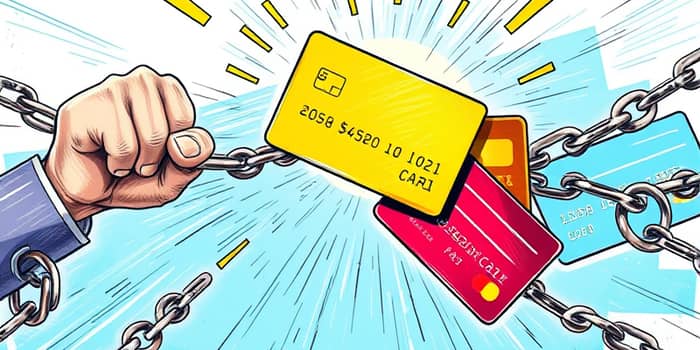
Debt can feel like an anchor dragging you down every month. Late fees stack up and interest rates soar, making it seem impossible to break free. Yet, there is a proven strategy that transforms chaos into clarity. Streamline your debt into one payment, lower your interest costs, and reclaim peace of mind.
The process of credit card consolidation involves combining several credit card balances into a single bill using another financial product. It does not erase debt but makes it far more manageable. By harnessing lower interest rates or structured repayment terms, you can pay down the same total amount more efficiently.
The primary objective is simple: avoid overwhelming multiple bill due dates and reduce the total interest you owe. Whether you choose a balance transfer card, a personal loan, or a home equity line, consolidation aims to set you on a focused path to becoming debt-free.
As of July 2025, the average credit card interest rate stands at 20.13%, whereas personal loans for those with solid credit average 12.65%. This gap creates a compelling opportunity to enjoy substantial interest rate savings by moving high-rate balances to lower-rate products.
With the current economic landscape showing signs of stability and consumer lending remaining competitive, qualifying for favorable consolidation terms is more achievable than ever. If you have a reliable income and maintain good credit, consolidating debt could save you thousands over time.
Selecting the right consolidation route depends on your unique needs, timeline, and risk tolerance. Below is a summary of the most common approaches:
Implementing a consolidation plan requires careful preparation and discipline. Follow these essential steps to ensure success:
Consolidation can deliver a range of financial and emotional rewards. When executed properly, you may experience:
While powerful, consolidation is not without its pitfalls. Be mindful of upfront charges such as 3–5% balance transfer fees or loan origination fees. Secured options could jeopardize your home or other assets, and introductory APR periods may expire, triggering higher rates. There is also the temptation to accumulate new credit card debt if spending habits aren’t addressed, and you may see a temporary dip in your credit score from hard inquiries.
If you have multiple high-rate credit card balances and qualify for a lower-rate product, consolidation can be a transformative tool. Those with good credit scores (FICO 670 or higher) will see the most advantage. However, individuals who struggle with impulsive spending or face imminent financial hardship should weigh alternatives like credit counseling or debt settlement.
Ultimately, the best path is the one that aligns with your long-term financial goals, risk tolerance, and readiness to adopt disciplined spending habits. By doing so, you can overcome financial obstacles with confidence and move toward a debt-free future.
Not everyone will find consolidation to be the best solution. Some individuals may benefit more from alternative strategies such as debt settlement, credit counseling, or negotiating directly with creditors. Debt settlement can reduce what you owe, but it often comes with significant credit score implications and potential tax consequences. Credit counseling agencies offer personalized budgeting advice and can guide you through a Debt Management Plan without adding new loans.
Consulting a qualified financial advisor or credit counselor can provide unbiased insight tailored to your situation. These professionals can help you weigh the true cost of consolidation versus alternative paths, ensuring you make an informed decision that aligns with your long-term financial health goals.
Credit card consolidation is not a magic bullet, but it is one of the most effective strategies for those ready to commit to a structured payoff plan. It combines multiple payments into one, offers potential interest savings, and can set a clear date for freedom from debt. Like any financial decision, it demands careful research, honest self-assessment, and steadfast adherence to your repayment schedule.
Begin by tallying your balances, exploring your options, and choosing the route that best fits your lifestyle and risk profile. With the right approach and mindset, you can transform a tangled web of credit card bills into a single, achievable goal—and finally reclaim control of your financial destiny.
References













